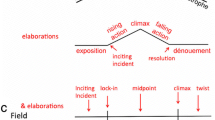Abstract
The world of everyday interactions is filled with characters, real or fictitious, and human knowledge of how to make these interactions satisfying and productive relies upon an understanding of character. As agents become more intelligent and more ubiquitous, we may naturally ask how we can endow them with life and personality to make them easier and more gratifying to use. This paper offers a broad definition of “animate character,” and examines the technical and artistic issues involved both in the creation and the evaluation of such systems. We provide example interactions with several character types. The paper concludes with an annotated bibliographic survey of work done in this area.
Similar content being viewed by others
References
L. Abbott, Active Acting: Exercises and Improvisations Leading to Performance, Star Publishing Company: Belmont, CA, 1987.
J. Bates, “The Nature of Characters in Interactive Worlds and The Oz Project,” School of Computer Science, Carnegie Mellon University, Pittsburgh, PA, Tech. Report, CMU-CS–92–200, Oct. 1992.
J. Bates, “The role of emotion in believable agents,” in Comm. of the ACM, vol. 37–7, pp. 122–125, 1994.
P. Curtis, “Mudding Social Phenomena in Text-Based Virtual Realities,” in Proc. 1992 Conf. on Directions and Applications of Advanced Computing, Berkeley, CA, May 1992.
C. Dyer, “Interpersonal goals and satisfaction with interactions.” Ph. D. Thesis, Dept. of Communications, Stanford Univ., Stanford, CA, 1993.
L. Egri, The Art of Dramatic Writing. Simon & Schuster: New York, 1949.
C. Elliott, “The Affective Reasoner: A Process Model of Emotions in a Multi-Agent System.” The Institute for the Learning Sciences, Ph. D. Thesis, Northwestern Univ., 1992.
S. Fiske and S. Taylor, Social Cognition. McGraw-Hill: New York, 1991.
L. Foner, “What's An Agent, Anyway? A Sociological Case Study,” M. I. T. Media Lab., Massachusetts Inst. Technol., Cambridge, MA, Agents Memo 93–01, May 1993.
D. Goleman, Emotional Intelligence, Bantam Books: New York, 1997.
B. Hayes-Roth, L. Brownston, R. Huard, B. Lent, and E. Sincoff, “Directed improvisation,” Knowledge Systems Lab., Stanford Univ., Stanford, CA, Tech. Report KSL–94–61, Sept. 1994.
B. Hayes-Roth, R. v. Gent, and D. Huber, “Acting in character,” in Creating Personalities for Synthetic Actors, R. Trappl and P. Petta, Eds. Springer-Verlag: Berlin, 1997.
B. Hayes-Roth and R. van Gent, “Improvisational Puppets, Actors, and Avatars,” in Proc. Computer Game Developers' Conf., Santa Clara, pp. 199–208, 1996.
B. Hayes-Roth and R. van Gent, “Story-Making with Improvisational Puppets,” in Proc. 1st Int. Conf. on Autonomous Agents, Marina del Rey, CA, pp. 1–7, Feb. 1997.
B. Hayes-Roth, “Mask and Cyber Mask,” in Proc. Computer Game Developers' Conf., Santa Clara, CA, 1997.
A. Horton. Writing the character-centered screenplay. University of California Press: Berkeley, CA, 1994.
R. Huard, and B. Hayes-Roth. “Character mastery with improvisational puppets,” in Notes of the IJCAI' 97 Workshop on Animated Interface Agents, Nagoya, Japan, Aug. 1997, pp. 85–90.
K. Isbister. “Personality in Interactive Computer Characters: The Importance of Consistency,” unpublished manuscript.
K. Isbister, and B. Hayes-Roth, “Social Interaction with Characters,” Submitted to J. of Applied AI, Special Issue on Animated Interface Agents, 1998.
W. James, Psychology. Holt: New York, 1900.
K. Johnstone, IMPRO: Improvisation and the Theater. Routledge: New York, 1992.
C. Jones, Chuck Amuck: The Life and Times of an Animated Cartoonist. Avon Books: New York, 1990.
J. Lasseter, “Principles of traditional animation applied to 3D animation,” in Proc. SIGGRAPH' 87, Anaheim, FL, pp. 35–44, July 1987.
H. Maldonado, A. Picard, P. Doyle, and B. Hayes-Roth, “Tigrito: A Multi-Mode Interactive Improvisational Agent,” in Proc. 1998 Int. Conf. on Intelligent User Interfaces, San Francisco, CA, pp. 29–32, Jan. 1998.
M. Mauldin, “ChatterBots, TinyMUDs, and the Turing test: Entering the Loebner prize competition,” in Proc. 12th Natl. Conf. on Artif. Intell., Seattle, WA, pp. 16–21, July 1994.
S. McCloud, Understanding Comics: The Invisible Art. HarperPerrenial: New York, 1993.
Y. Moon, “Can computer personalities be human personalities?” in Int. Journal of Human-Computer Studies, vol. 43, pp. 223–239, 1995.
J. Murray, Hamlet on the Holodeck: The Future of Narrative in Cyberspace. The Free Press: New York, 1997.
S. Nachmanovitch. Free Play: Improvisation in Life and Art. Jeremy P. Tarcher, Inc.: Los Angeles, 1991.
A. Newell. Unified Theories of Cognition. Harvard University Press: Cambridge, MA, 1990.
D. Norman, Things That Make Us Smart. Addison-Wesley: Reading, MA, 1993.
K. Perlin, “Real time responsive animation with personality,” IEEE Transactions on Visualization and Computer Graphics, vol. 1, 1995.
K. Perlin and A. Goldberg, “Improv: A System for Scripting Interactive Actors in Virtual Worlds,” Computer Graphics, vol. 29, 1996.
R. Picard, Affective Computing. MIT Press: Boston, MA, 1997.
B. Reeves and C. Nass, The Media Equation: How People Treat Computers, Televisions, and New Media Like Real People and Places. Cambridge University Press: New York, 1996.
D. Rousseau and B. Hayes-Roth, “Improvisational synthetic actors with flexible personalities,” Knowledge Systems Lab., Stanford Univ., Stanford, CA, Tech. Report KSL–97–08, Sept. 1997.
D. Tannen, You Just Don't Understand: Women and Men in Conversation. William Morrow & Co.: New York, 1990.
D. Tannen, Talking From 9 to 5: Women and Men in the Workplace: Language, Sex, and Power, Avon Books: New York, NY, 1997.
F. Thomas and O. Johnston, The Illusion of Life: Disney Animation. Hyperion Books: New York, 1981.
R. Trappl and P. Petta, Eds. Creating Personalities for Synthetic Actors. Springer-Verlag: Berlin, 1996.
M. A. Walker, J. E. Cahn, and S. J. Whittaker, “Improvising Linguistic Style: Social and Affective Bases of Agent Personality,” in Proc. 1st Int. Conf. on Autonomous Agents, Marina del Rey, CA, pp. 96–105, Feb. 1997.
J. Weizenbaum, “ELIZA—A Computer Program for the Study of Natural Language Communication Between Man and Machine,” in Comm. of the ACM, vol. 9, 1, pp. 36–45, 1966.
P. Zimbardo and M. Leippe, The Psychology of Attitude Change and Social Influence, McGraw-Hill: New York, 1991.
Author information
Authors and Affiliations
Rights and permissions
About this article
Cite this article
Hayes-Roth, B., Doyle, P. Animate Characters. Autonomous Agents and Multi-Agent Systems 1, 195–230 (1998). https://doi.org/10.1023/A:1010019818773
Issue Date:
DOI: https://doi.org/10.1023/A:1010019818773




